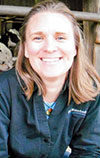If you’re thinking about making a few changes to your freestall bedding area, take an extra peek at some commonly overlooked areas to ensure you don’t miss something in the planning steps.
“Measure twice, cut once.” We’ve likely all heard that common adage before, but what they forget to say (but is implied) is if you measure twice and only cut once, you only pay once too. It’s not necessarily just paying for the product or service you think you’re getting. On the dairy, if you shortchange yourself in the planning process or aren’t working with someone who will help you think through more than just the “best case” scenario, the areas where you will pay more than once will add up too. If you don’t order the correct parts, you can lose time and further disrupt your cows, which adds up to lower milk production, has a possible impact on reproduction and increases overall cow stress.
Here are three tips for a facility renovation:
1. Every stall matters
It is not uncommon for the end stall in a row of freestalls to be narrower than you might think. Often, these stalls have been “cheated” out of a few inches of width, giving up several inches of stall space to allow for a wider alley without changing the overall length of the barn. While you may not have taken a tape measure to it during original construction, this stall size variation is important to note in a renovation project.
If your end stalls are as much as 6 inches smaller than most of your other stalls, you may need to order a different size mattress or waterbed than the majority of your stalls. You may also need additional hardware to properly complete the installation. Realizing on installation day that you don’t have the right size surface or you don’t have enough hardware can set you back in express shipping charges and wasted time on the jobsite.
By assuming that all the stalls are the same width, you will end up with additional project costs and wasted time.
2. Stall dividers move
Let’s face it; the stall dividers have moved over time. Whether the cows have moved them, a skid steer hit them and they’ve been moved back into place, or the fastening brackets have loosened over time, those new stalls you put in the barn years ago are not the same as today.
Measure the total length of the platform. Divide the total length by the total number of stalls that you currently have or that you want to have, if you are widening (or shrinking) the stalls. What’s the closest even number? Is that width for the stall what is recommended for the size of cow you will be housing in the barn or pen? Can you reset the stall loops to that size? If you’re changing loops but not changing the posts, will the old post hold the new loop? What is the impact of moving your stall dividers on your stall base? Or a new stall base, if you are changing that too?
Stall dividers play a critical role in positioning the cow in the stall to help keep her comfortable and dry, and the surface clean.
3. Provide a drawing
You took all the right measurements, wrote everything down and then life took over. You don’t go back to the measurements for six weeks and then you can’t remember what you wrote down. Or you try to explain your measurements to someone from the dealership’s office and they just don’t get it.
Pictures or hand-drawn maps help the barn come to life for someone sitting in front of a computer screen and parts book. Pictures and maps can also help installation crews so they know exactly where to look for tools, water sources, electrical outlets, offices to check in and areas to work. A drawing can provide clarity when ordering and planning for installation, and can save time during the installation process.
Every dairy is different. Likely, every barn on your dairy is a little different. Ideal measurements in a renovation are rarely possible, so use everything you can to make a good decision about what you can change, and understand the impact one change has on another.
Every little bit of time, money and effort adds up. Make sure you’re adding it up in the black and not the red. ![]()

-
Amy Throndsen
- Chief Operating Officer
- Advanced Comfort Technology
- Email Amy Throndsen





